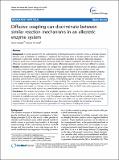Por favor, use este identificador para citar o enlazar a este item:
http://hdl.handle.net/10261/33103COMPARTIR / EXPORTAR:
 SHARE
BASE SHARE
BASE
|
|
| Visualizar otros formatos: MARC | Dublin Core | RDF | ORE | MODS | METS | DIDL | DATACITE | |

| Título: | Diffusive coupling can discriminate between similar reaction mechanisms in an allosteric enzyme system |
Autor: | Straube, Ronny; Nicola, Ernesto M. CSIC | Fecha de publicación: | 30-nov-2010 | Editor: | BioMed Central | Citación: | BMC Systems Biology 4(1) : 165- (2010) | Resumen: | Abstract Background A central question for the understanding of biological reaction networks is how a particular dynamic behavior, such as bistability or oscillations, is realized at the molecular level. So far this question has been mainly addressed in well-mixed reaction systems which are conveniently described by ordinary differential equations. However, much less is known about how molecular details of a reaction mechanism can affect the dynamics in diffusively coupled systems because the resulting partial differential equations are much more difficult to analyze. Results Motivated by recent experiments we compare two closely related mechanisms for the product activation of allosteric enzymes with respect to their ability to induce different types of reaction-diffusion waves and stationary Turing patterns. The analysis is facilitated by mapping each model to an associated complex Ginzburg-Landau equation. We show that a sequential activation mechanism, as implemented in the model of Monod, Wyman and Changeux (MWC), can generate inward rotating spiral waves which were recently observed as glycolytic activity waves in yeast extracts. In contrast, in the limiting case of a simple Hill activation, the formation of inward propagating waves is suppressed by a Turing instability. The occurrence of this unusual wave dynamics is not related to the magnitude of the enzyme cooperativity (as it is true for the occurrence of oscillations), but to the sensitivity with respect to changes of the activator concentration. Also, the MWC mechanism generates wave patterns that are more stable against long wave length perturbations. Conclusions This analysis demonstrates that amplitude equations, which describe the spatio-temporal dynamics near an instability, represent a valuable tool to investigate the molecular effects of reaction mechanisms on pattern formation in spatially extended systems. Using this approach we have shown that the occurrence of inward rotating spiral waves in glycolysis can be explained in terms of an MWC, but not with a Hill mechanism for the activation of the allosteric enzyme phosphofructokinase. Our results also highlight the importance of enzyme oligomerization for a possible experimental generation of Turing patterns in biological systems. | URI: | http://hdl.handle.net/10261/33103 | Identificadores: | http://dx.doi.org/10.1186/1752-0509-4-165 |
| Aparece en las colecciones: | (IFISC) Artículos |
Ficheros en este ítem:
| Fichero | Descripción | Tamaño | Formato | |
|---|---|---|---|---|
| 1752-0509-4-165.xml | 179,75 kB | XML | Visualizar/Abrir | |
| 1752-0509-4-165.pdf | 738,93 kB | Adobe PDF |  Visualizar/Abrir |
CORE Recommender
Page view(s)
298
checked on 19-abr-2024
Download(s)
268
checked on 19-abr-2024
Google ScholarTM
Check
NOTA: Los ítems de Digital.CSIC están protegidos por copyright, con todos los derechos reservados, a menos que se indique lo contrario.
